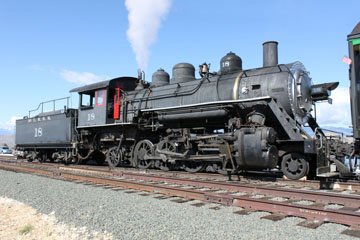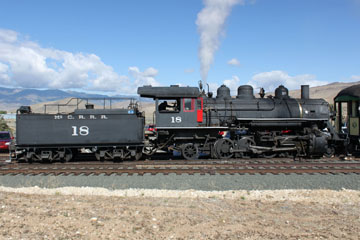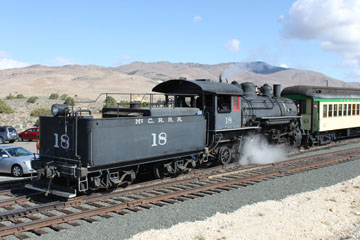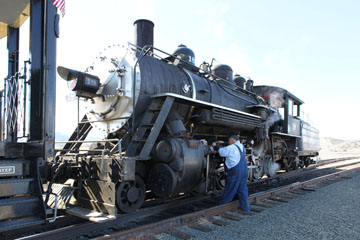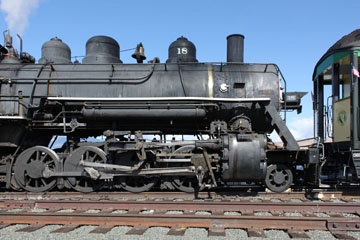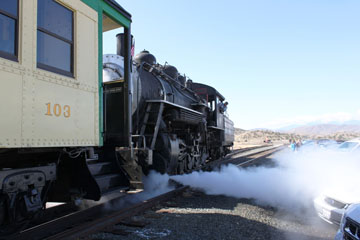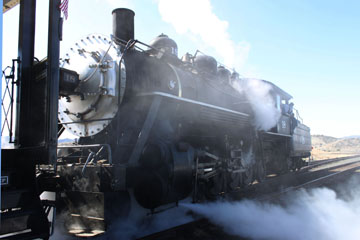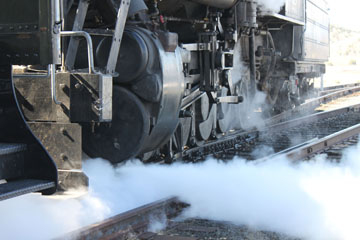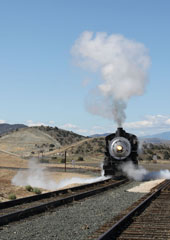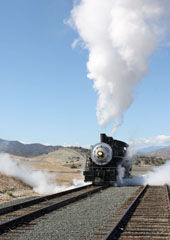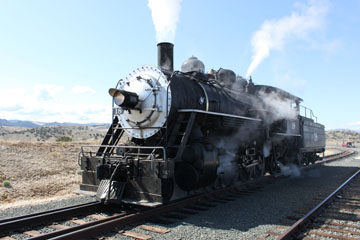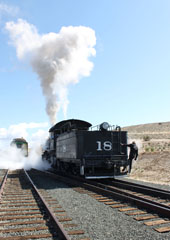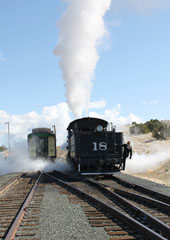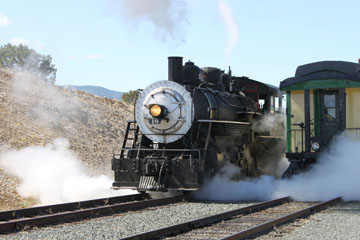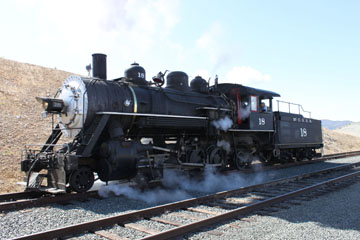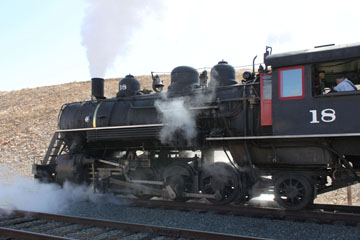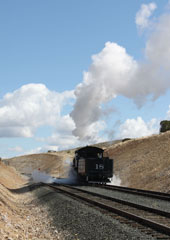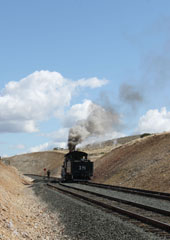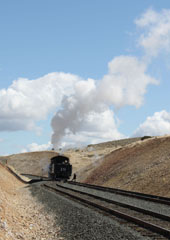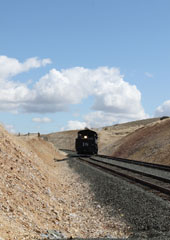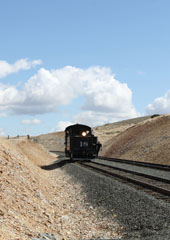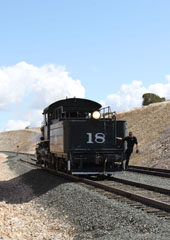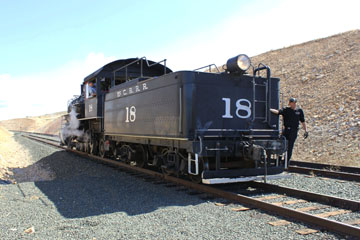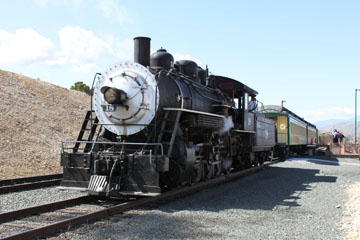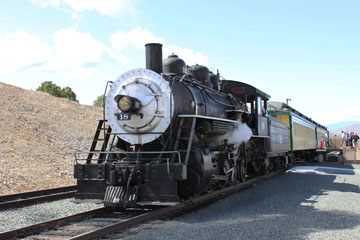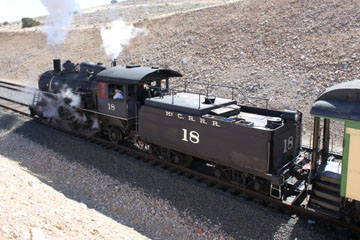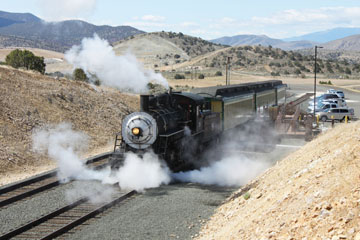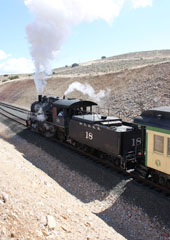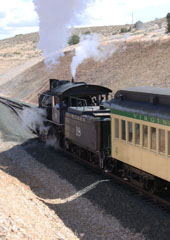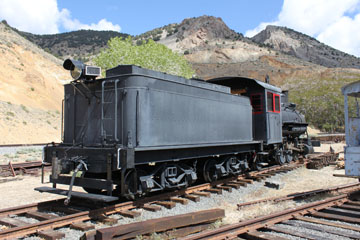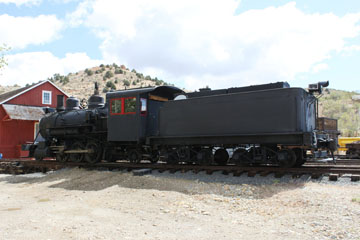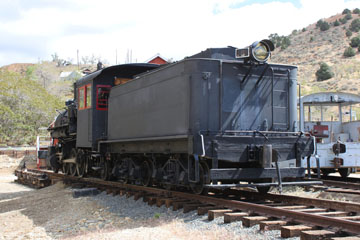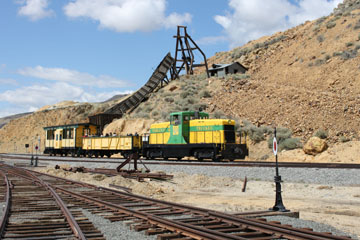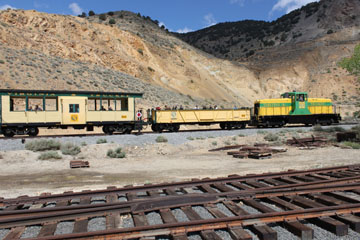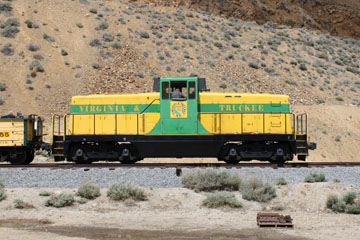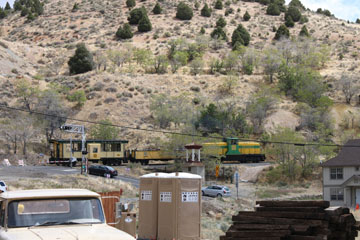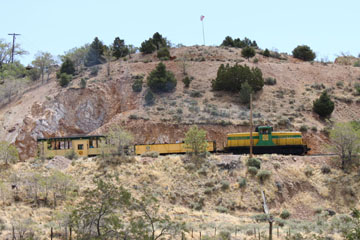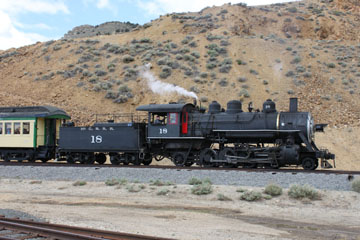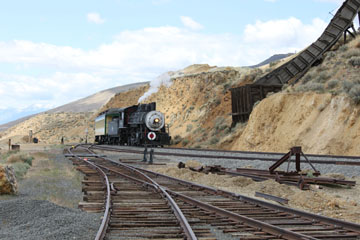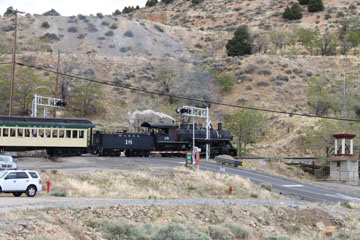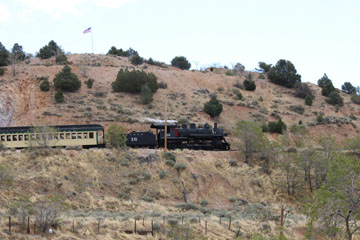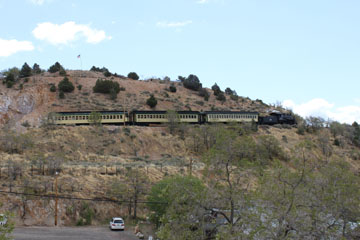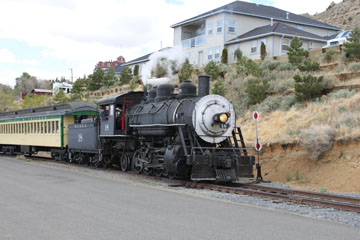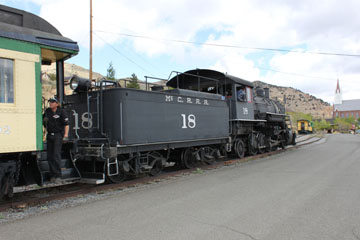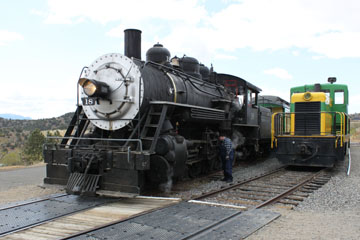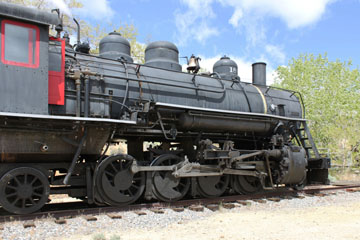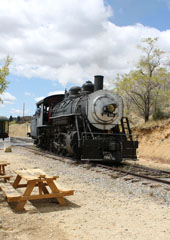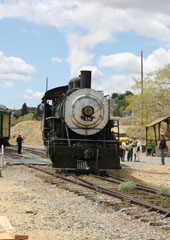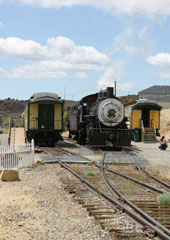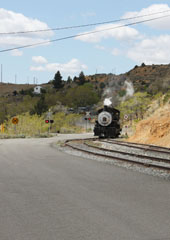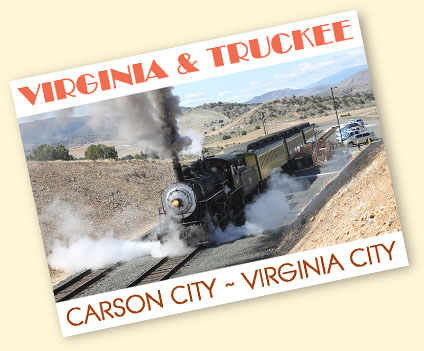

When I visited the Virginia & Truckee Railroad in June one year, ex-McCloud River Railway #18 was hauling the train from Carson City to Virginia City, NV.
#18 was bought from the McCloud Railway Company in 2005. After three years on loan to the Sierra Railroad in Oakdale, CA, it was shipped to Nevada in 2010 and hauled its first excursion on 24th July 2010.
Although Carson City was the headquarters of the original V&T from 1900, after the railroad was abandoned in 1950, most of the equipment and infrastructure was removed. Only the 1872 passenger depot remains at 729 North Carson Street. It was bought by the Carson City Freemasons Masonic Lodge #1 in 1952 and has since been used as a meeting hall and commercial office space. However, several ex-V&T locomotives have survived. You can see some on the Nevada State Railroad Museum and California State Railroad Museum pages of this website.
With no surviving infrastructure in Carson City, the current V&T departs from the stub of the railroad off Flint Drive, six miles east of Carson City on US highway 50.

The consist comprised two flatcars loaded with the finest specimens of Ponderosa Pine the McCloud Company could find, a boxcar loaded with lumber from the mill, and caboose #015. After the exposition, #18 returned to haul freight on the McCloud River Railroad.
The MCRR was chartered in 1897 as a common carrier connecting Mount Shasta and McCloud, CA. It owned all the rails used by the lumber company and leased most of the motive power, all the log cars and most of the service cars. It also ran passenger services until 1952.
Above, #18 had already pulled in empty from Virginia City when I arrived at Flint Drive.
This Mikado (2-8-2) type locomotive was built by Baldwin in 1914 for the McCloud River Lumber Company. Before going into service, it joined a display at the 1915 Panama-Pacific Exposition in San Francisco celebrating completion of the Panama Canal. McCloud River, the Weed Lumber Company and the Red River Lumber Company jointly sponsored the display, the centrepiece of which was a house built entirely of products from the three companies’ sawmills.
Steam power ended on the McCloud River
Railroad in 1956 and, that year, after forty-one years service on the railroad, #18 was sold to the Yreka Western, a northern California tourist operation.
After eight years in service on the Yreka Western, in 1964, the locomotive blew a cylinder head hauling a special excursion. It then went into storage at Yreka until bought by the new McCloud Railway Company in 1998. Restored to operating condition, #18 hauled its first excursion on its home rails on 18th February 2001, doubleheading with MCR #25. In 2005, however, the railroad applied to abandon its line and #18 hauled its last MCR excursion on 7th August that year.
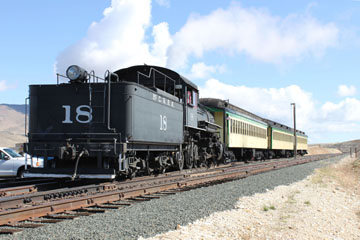
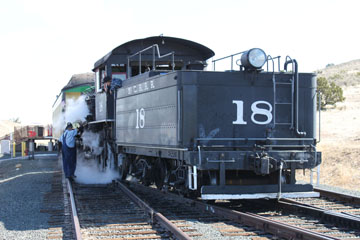
#18 is basically a powered up version of two MCRR Baldwin Mikados, #14 & #15 delivered in 1907. Like them, #18 is an oil burner weighing 179,000 lbs, 143,000 lbs on its 48” drivers. It has the same 13’ 1” driver wheelbase but a slightly longer, 27’ 1” engine wheelbase.
Although the 154 sq ft firebox was a slight increase over the earlier 148 sq ft, the total heating surface dropped 162 sq ft to 2,994 sq ft. The main difference was the 519 sq ft of superheating and an increase in the firebox heating surface from 148 sq ft to 154 sq ft.
Top photo above, the engineer and conductor check out the air compressors while the fireman looks on. The tender weighs 80,000 lbs light and has a capacity of 4,000 gallons of water and 2,800 gallons of oil.
Lower photo above, the engineer greases the
valve spindle crosshead. Inspecting, greasing and oiling of parts is carried out regularly by crews whenever steam locomotives stop for any length
of time on their runs. Like #14 & #15, #18 has
20” x 28” cylinders but, operating at a boiler pressure of 200 psi instead of 180 psi, with the other changes in design, it delivered 39,667 lbs tractive effort, an 11% increase over the older locomotives’ 357,000 lbs.
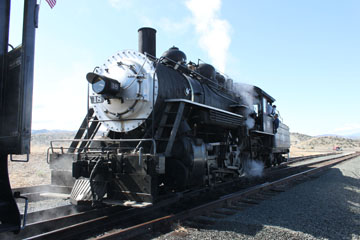
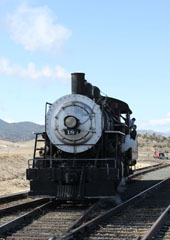
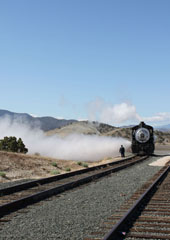
#18 then uncouples and reverses to a clear section of track to blow down the boiler. Because of the high heat and pressure in the boiler, a significant amount of flash steam is produced.
Dissolved solids and particles enter the locomotive's boiler with the water and remain when steam is generated. If not exhausted in this way, the solids build up and, finally, a concentration can be reached where operation of the boiler becomes impossible and even dangerous. If they are not purged they can lead to scale formation, corrosion and embrittlement of the boiler walls. Reduced heat transference can then cause firebox walls to overheat and collapse, resulting in a boiler explosion!
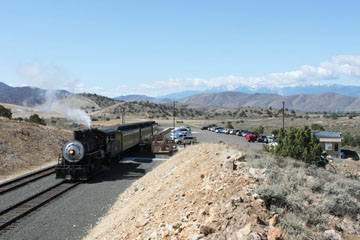
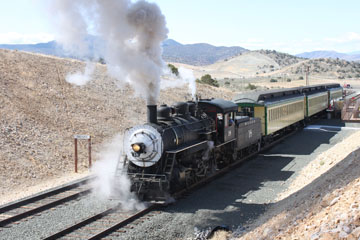
Above, all the passengers have boarded and #18 stands ready to depart. Although the photo was taken in early June, there is still snow on the distant Sierra Nevadas. Carson City is just behind the low hills in the middle distance and the old V&T right of way is still evident curving round the hills to the right. The small building on the far right of the photo is the ticket office. The V&T plan to build a more substantial depot building here in the future.
Below and right, #18 starts out on the 1½ hour 21 mile trip to Virginia City.

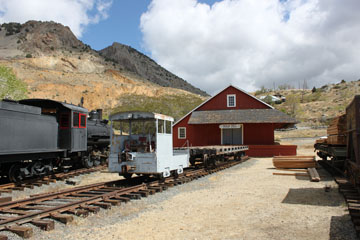
Above, the historic V&T depot building at Gold Hill. It was built in 1869. Intended as a temporary structure on one of the few parts of the township with level land, it has managed to survive over one hundred and forty years and is now owned and operated as a museum by the Gold Hill Historical Society.
The V&T started a line from Carson City to
Virginia City in 1869, reaching Gold Hill in September that year and Virginia City in early January 1870. Gold Hill grew at the site of a major source of silver ore discovered in 1859 by James Finney and Henry Comstock, who gave his name to the famed "Comstock Lode". The town was incorporated in 1862, apparently to avoid being subsumed by neighbouring Virginia City. Prospectors, speculators and trades people flocked to the area and, at one point, the town was home to at least 8,000 residents. Prosperity lasted for about twenty years from 1868 to 1888, particularly after the "Big Bonanza" strike of several new ore veins in 1873.
There was later mining activity between 1927 and 1942, but this petered out from about 1933. The Post Office closed in 1943 and, during the following years, the town was progressively abandoned. Today there are only a couple of hundred local residents.
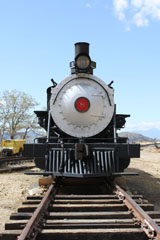
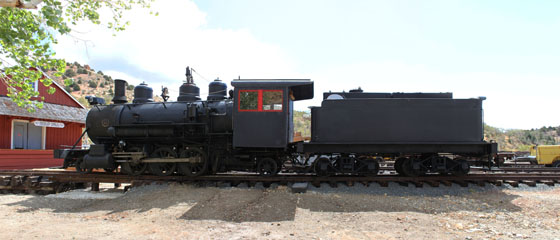
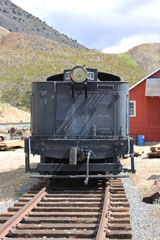
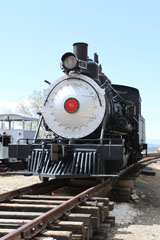
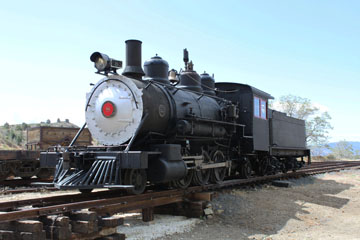
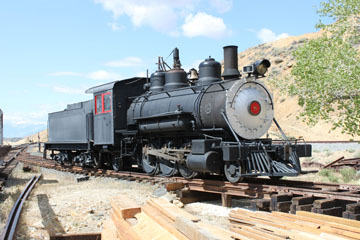
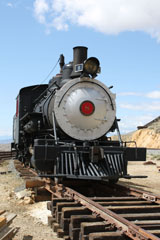
On display at Gold Hill, Feather River Shortline #8, a Prairie type (2-6-2) locomotive built by Baldwin in 1907.
#8 was bought by the Sierra Nevada Wood & Lumber Co., in Hobart Mills, CA, for the company's standard gauge connection from Hobart Mills to Truckee. In 1938, it was sold to the Clover Valley Lumber Co., in Loyalton and, some time after, to the Feather River Lumber Co., where it worked until 1956. It was then donated to the Plumas County Fair Association in 1958, with the intention of putting it on static display at the Quincy, CA, Fairgrounds.
The Feather River Shortline Railroad was established by the Plumas County Fair
Association to preserve and display the locomotive. In 1962, the Northern California R&LHS agreed to restore #8 and steam it the eight miles from storage on a siding at Quincy to Quincy Junction and back. It operated for a time at the Portola Railroad Museum and then moved to the V&T in 1989 where it did special runs, double headers and became the primary motive power when #29 was being serviced. It remains the property of the FRSR.
An oil burner, #8 weighs 76,000 lbs, 56,000 lbs
on its 44” drivers. With Stephenson valve gear,
13” x 22” cylinders, a 13.3 sq ft grate, 74 sq ft firebox and total heating surface of 767 sq ft, it operated at a boiler pressure of 160 psi delivering 11,492 lbs tractive effort.
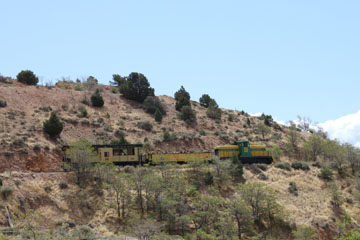
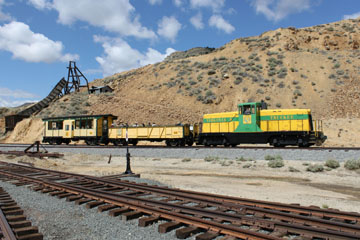
Above, while I was waiting for #18, VT D-1 came growling down the hill. It was behind a short, thirty-five minute round trip excursion from Virginia City to Gold Hill and back.
Two years after completing the twenty-one mile line from Virginia City to Carson City, the V&T
built a thirty-one mile extension north from Carson City through Franktown, Washoe City and Steamboat Springs to connected with the Southern Pacific at Reno. In 1905, a fifteen mile branch line south from Carson City to Minden completed the V&T system.
Above, the train passes an old silver flume. GE built D-1 in 1953 for the US Navy. As USN
#65-00387 it was initially based at the Naval Supply Center in Mechanicsburg, PA. In 1971, it was assigned to the US Army as US #1694 and worked at Curtis Bay, MD. It then went into storage at Hill Air Force Base in Utah in 1977 and was bought by the V&T in 2003.
GE built two hundred and sixty of these 80 ton switchers for US railroads between 1941 and
1974, as well as twenty for the US Air Force, one hundred and twenty-one for the Army, five for the Marine Corps and sixty-two for the Navy. A number are still in use at military facilities across the country.
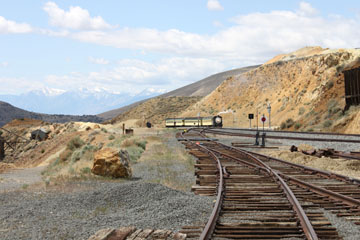
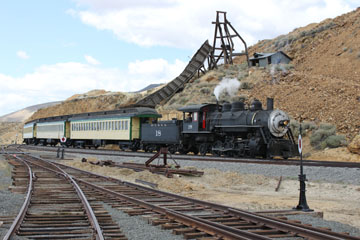
Above, a little while later, #18 heaves into view after climbing over 1,100 feet from Flint Drive. It still has more than 300 feet to climb on the way to Virginia City.
The V&T had been built to meet the demands of the silver boom and, for the first twenty years made handsome profits, with dividends running at $100,000 a month in the 1870s. As the mines played out during the 1890s and 1900s, however, business began to decline. Then, with the growth of automotive travel, even traffic on the Minden branch began to fall.
Above, #18 passes through the Gold Hill yard.
During the 1930s, the V&T struggled on. From 1932 to 1937, Ogden L. Mills, stockholder and grandson of co-founder Darius Ogden Mills, loaned nearly $95,000 to balance operating deficits. Mills died in 1937 and the railroad was forced into receivership. With little traffic and several collapsed tunnels, the line from Virginia City to Carson City was closed in 1938. The rails were torn up in 1941 and sold, the resulting $52,000 going towards deferred maintenance. The last revenue train was hauled by VT #27 on 31st May 1950 from Reno through Carson City to Minden (you can see #27 on the Nevada State Railroad Museum page of this website).

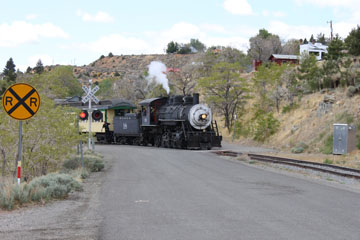
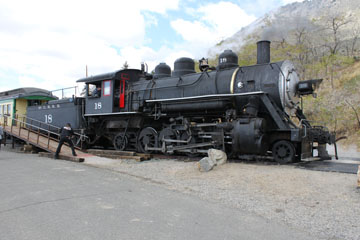
Above, preparing to disembark the passengers from the train.
After abandonment of the Minden line, the rails were lifted and most of the V&T’s remaining assets were sold. As business contracted, a number of the locomotives had already been scrapped, gifted, leased or sold prior to 1950. Some worked on for other railroads and several would have a new life in film and television. What was left went at auction that year, some of it subsequently scrapped or dispersed to different locations throughout the country.
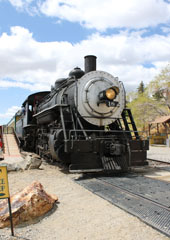
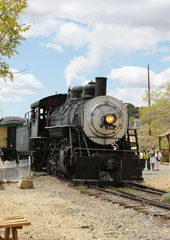
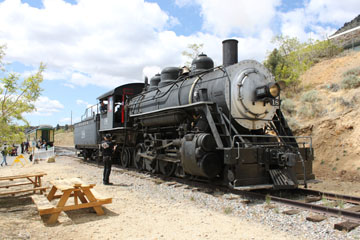
#18 uncouples and steams forward. It will then back across a switch and run in reverse to the engine house to take on water.
After twenty years lying neglected, in 1971, Robert Gray, a businessman and railroad buff from California saw the potential to bring the V&T back to life. He began to buy old rights of way, motive power and rolling stock, and was the driving force behind the railroad’s rebirth in 1976. By 1991, excursions were running on a two mile section of line between Carson City and Gold Hill. In 2009,
the line was extended between Gold Hill and Flint Drive bringing the total trackage to 12½ miles. Roughly 40,000 people now ride the trains each year.


